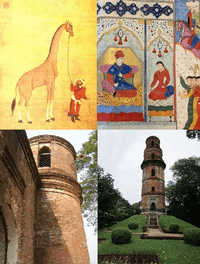Shamsuddin Ilyas Shah
Shamsuddin Ilyas Shah (Bengali: শামসুদ্দীন ইলিয়াস শাহ, Persian: شمس الدین الیاس شاه) was the founder of the Bengal Sultanate. He established the Ilyas Shahi dynasty, an Indo-Turkic dynasty which ruled Bengal for 150 years.[3]
| Shamsuddin Ilyas Shah | |
|---|---|
| Ruler of Satgaon[2] | |
| Reign | 1342–1352 |
| 1st Sultan of Bengal | |
| Reign | 1352–1358 |
| Successor | Sikandar Shah |
| Issue | Sikandar Shah |
| House | Ilyas Shahi dynasty |
| Religion | Islam |
Ilyas Shah was a Sistani Sunni Muslim who rose through the ranks of the Delhi Sultanate. In the early 14th-century, the Delhi Sultanate divided Bengal into three provinces based in the towns of Satgaon in South Bengal, Sonargaon in East Bengal, and Lakhnauti in North Bengal. The purpose was to improve administration as Delhi's sway over Bengal weakened. Ilyas Shah was appointed Governor of Satgaon. In the middle of the 14th-century, the governors of the three city-states declared independence. The three city-states began warring against one another. Ilyas Shah eventually defeated the ruler of Lakhnauti Alauddin Ali Shah and the ruler of Sonargaon Ikhtiyaruddin Ghazi Shah. He unified Bengal into an independent sultanate and established his capital in Pandua.
As Sultan, Ilyas Shah waged a war against the Delhi Sultanate to secure recognition of Bengal's independence. He raided cities across the eastern part of the Indian subcontinent, becoming the first Muslim ruler to invade the Kathmandu Valley. Eventually, he reached an agreement with Delhi to pay an annual tribute in return for a cessation of hostilities.
Early life
Shamsuddin Ilyas was born into an aristocratic family in the Sistan region of what is today eastern Iran and southern Afghanistan. He worked under the service of the Delhi Sultanate. He migrated to Bengal and worked under Izzuddin Yahya, the imperial provincial governor of Satgaon.
Unification of Bengal

By the mid 14th century, three Muslim city states emerged in Bengal after declaring independence from the Delhi Sultanate: Lakhnauti (ancient Gauda) in North Bengal, Sonargaon in East Bengal and Satgaon in South Bengal. In 1338, after Izzuddin Yahya's death, Ilyas declared himself as the Sultan of Satgaon, with the title Shamsuddin Ilyas Shah. He then waged a long drawn war from 1339 to 1352 against Sultan Alauddin Ali Shah of Lakhnauti and Sultan Ikhtiyaruddin Ghazi Shah of Sonargaon.[4] Ilyas Shah emerged victorious after conquering Lakhnauti and Sonargaon. He then proclaimed the establishment of the Sultanate of Bengal in Lakhnauti in 1352. The area was the former capital of the Gauda Kings and the Pal Emperors. He built his capital in nearby Pandua.
Government
Ilyas Shah displayed an egalitarian attitude towards his subjects; his administration was known for its equality and acceptance of members from different religious, caste, social, and ethnic communities. Ilyas Shah also founded the city of Hajipur. He standardized the people of Bengal under the banner of one politico-social and linguistic platform, including the Bengali language.[5] The region received immigrants from across the Muslim world, including North Indians, Turks, Abyssinians, Arabs and Persians.
Military campaigns
During the early period of his reign, Ilyas Shah led the first Muslim army into Nepal.[5] He occupied the Tirhut region and thrust through the Terai plains into the Kathmandu Valley. His army sacked the temple of Svayambhunath,[5] returning to Bengal with plentiful spoils. Ilyas Shah then invaded Orissa, which was ruled by Bhanudeva II of the Eastern Ganga dynasty. He further sacked Jajpur, Cuttack and reached as far as the Chilika Lake. He also led a successful campaign against the Kamarupa kingdom in present-day Assam.
In November 1353, the Delhi Sultan Firuz Shah Tughluq launched an invasion of Bengal. His army occupied Pandua. Ilyas Shah and his forces retreated to the fortress of Ekdala. The Delhi Sultan laid siege to the fortress for two months. The Delhi Sultanate's forces then began withdrawing. Ilyas Shah began to pursue the Delhi army and reached as far as Varanasi. The Delhi army formidably fought back. Firuz Shah returned to Delhi in 1355. Ilyas Shah regained control of Bengal and his realm extended up to the Koshi River.[4]
The extent of Ilyas Shah's campaigns, including his conquest of major Indian cultural centers, was considered "world-conquering" in the context of medieval India.[6] This led to him being styled as "the second Alexander" in the same manner as Alauddin Khalji.[6]
Notes
- http://en.banglapedia.org/index.php?title=Iliyas_Shah
- http://en.banglapedia.org/index.php?title=Iliyas_Shah
- Lewis, David (2011). Bangladesh: Politics, Economy and Civil Society. Cambridge University Press. p. 44. ISBN 978-1-139-50257-3.
- Tabori, Paul (1957). "Bridge, Bastion, or Gate". Bengali Literary Review. 3–5: 9–20.
- Ahmed, ABM Shamsuddin (2012). "Iliyas Shah". In Islam, Sirajul; Jamal, Ahmed A. (eds.). Banglapedia: National Encyclopedia of Bangladesh (Second ed.). Asiatic Society of Bangladesh.
- Eaton, Richard Maxwell (1996). The Rise of Islam and the Bengal Frontier, 1204–1760. University of California Press. ISBN 978-0-520-20507-9.
| Preceded by Dynasty created |
Sultanate of Bengal 1342–1358 |
Succeeded by Sikandar Shah |
